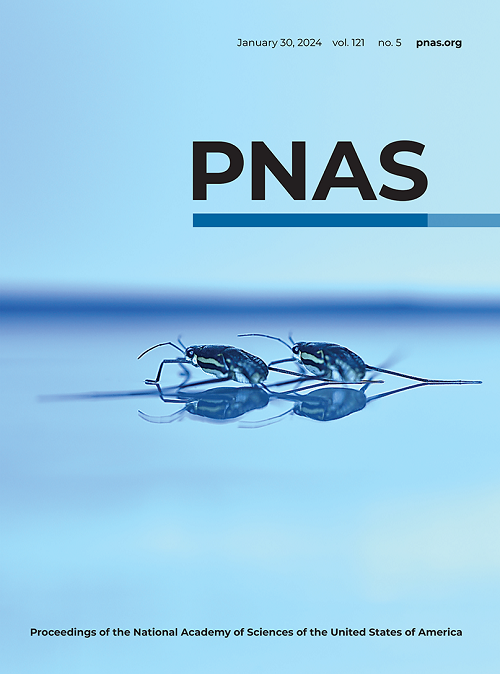乙酰化和PARylation对核小体核心颗粒中组蛋白尾部静电电位的调节
IF 9.1
1区 综合性期刊
Q1 MULTIDISCIPLINARY SCIENCES
Proceedings of the National Academy of Sciences of the United States of America
Pub Date : 2025-07-21
DOI:10.1073/pnas.2511507122
引用次数: 0
摘要
细胞DNA被一个八聚体包裹,该八聚体由四种组蛋白组成,构成染色质结构的基本单位,核小体核心颗粒(NCP)。组蛋白内在无序的尾部作为支架,结合一系列调节基因组保真度和基因表达的蛋白质。在尾部的各种翻译后修饰(PTMs)已被表征,包括一些改变它们的整体电荷;然而,不同PTMs的尾静电电位的每残基变化尚未见报道。在这里,我们使用溶液核磁共振方法,通过添加顺磁辅质来量化尾酰胺和甲基质子的横向弛豫率的增强,我们研究了乙酰化和PARylation如何调节组蛋白尾部静电电位。值得注意的是,尽管两种ptm都减少了每条尾巴携带的净正电荷,但相对于未修饰的NCP,它们的静电电位以尾巴特定的方式增加或减少。提出了一个简单的尾巴- dna相互作用模型来解释这些结果。本文章由计算机程序翻译,如有差异,请以英文原文为准。
Modulation of histone tail electrostatic potentials in nucleosome core particles by acetylation and PARylation
Cellular DNA is wrapped about an octamer composed of four histone proteins forming the fundamental unit of chromatin structure, the nucleosome core particle (NCP). The intrinsically disordered tails of the histones serve as scaffolds for binding an array of proteins that regulate the fidelity of the genome and gene expression. A variety of posttranslational modifications (PTMs) on the tails have been characterized, including some that alter their overall charge; however, per-residue changes in tail electrostatic potentials for different PTMs have not been reported. Here, using a solution NMR approach in which enhancements of transverse relaxation rates of tail amide and methyl group protons are quantified through the addition of paramagnetic cosolutes, we examine how acetylation and PARylation modulate histone tail electrostatic potentials. Notably, even though both PTMs decrease the net positive charge carried by each tail, their electrostatic potentials either increase or decrease in a tail-specific manner relative to an unmodified NCP. A simple model of tail–DNA interactions is presented to explain these results.
求助全文
通过发布文献求助,成功后即可免费获取论文全文。
去求助
来源期刊
CiteScore
19.00
自引率
0.90%
发文量
3575
审稿时长
2.5 months
期刊介绍:
The Proceedings of the National Academy of Sciences (PNAS), a peer-reviewed journal of the National Academy of Sciences (NAS), serves as an authoritative source for high-impact, original research across the biological, physical, and social sciences. With a global scope, the journal welcomes submissions from researchers worldwide, making it an inclusive platform for advancing scientific knowledge.

 求助内容:
求助内容: 应助结果提醒方式:
应助结果提醒方式:


